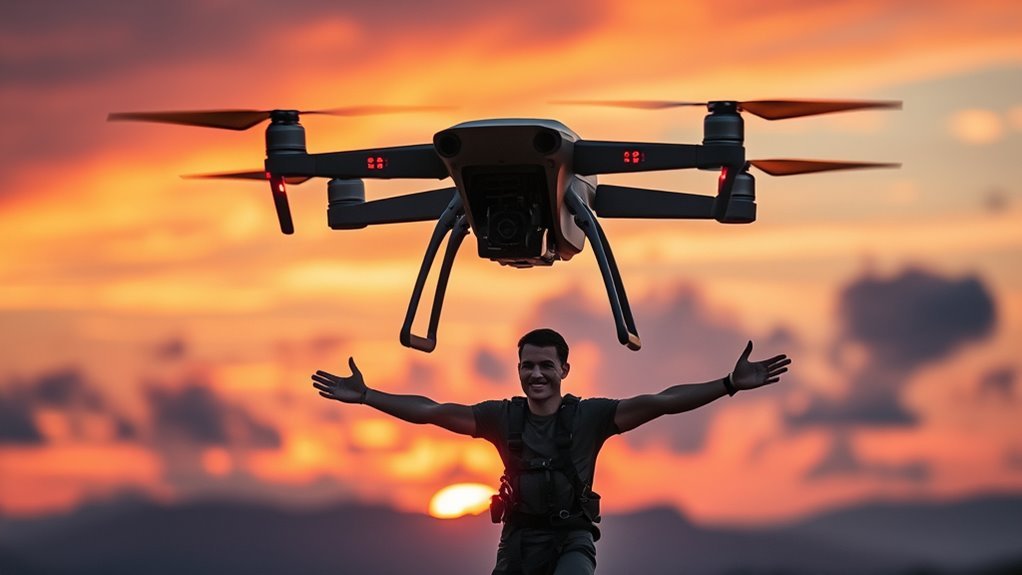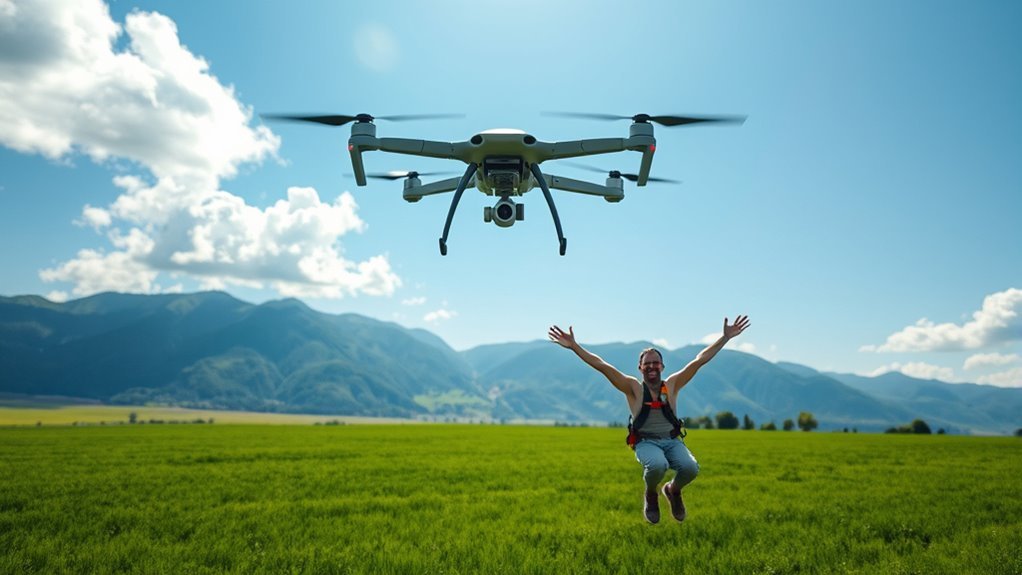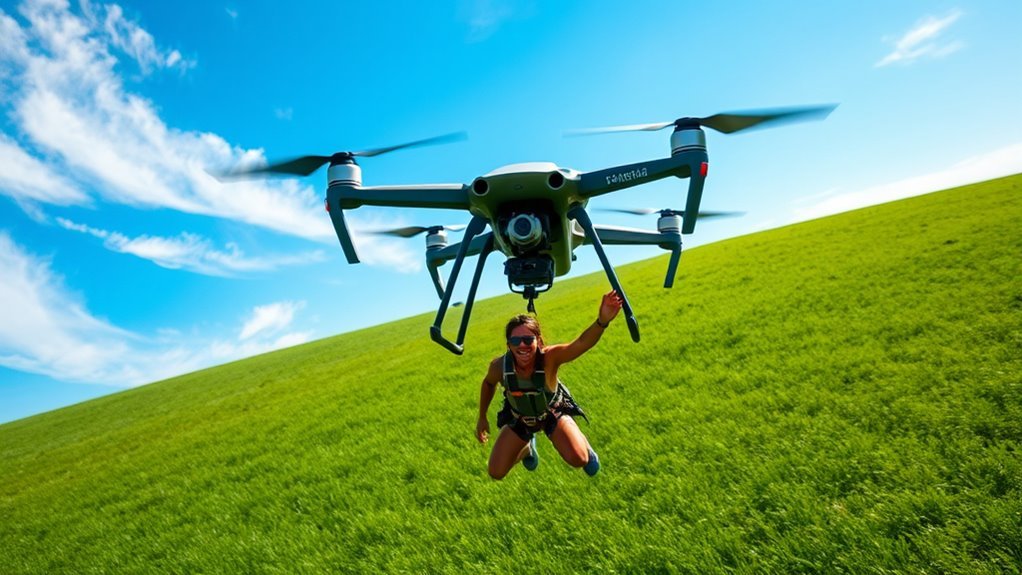Drones lifting a person face critical limits in weight capacity, flight duration, and safety regulations. Each drone’s design dictates its weight limit, while flight times typically range from 20-30 minutes, heavily influenced by battery efficiency. Compliance with local and federal laws is essential to guarantee safe operations. Technological hurdles, including power-to-weight ratios and advanced navigation systems, complicate development. Understanding these constraints will provide insight into the future of aerial transportation and emerging innovations.
Weight Capacity: Understanding the Limits

When it comes to drones capable of lifting a person, understanding weight capacity is essential. You need to take into account both the payload efficiency and the lift mechanisms at play. Each drone has a specific weight limit, determined by its design and motor power. Exceeding this limit not only compromises safety but also affects flight stability. The lift mechanisms, including rotor size and configuration, directly influence how much weight a drone can effectively carry. To maximize your freedom in flight, it’s vital to calculate your total weight, including gear and any additional payload. By ensuring you stay within the specified limits, you can optimize the drone’s performance while enjoying the exhilarating experience of personal aerial mobility. Additionally, drones like the EHang EH216-S prioritize passenger safety through advanced navigation and collision avoidance systems.
Flight Duration: How Long Can Drones Fly?

How long can drones actually sustain flight when lifting a person? The flight duration primarily hinges on battery efficiency and the drone’s design. Typically, you can expect:The flight duration of drones lifting a person depends on battery efficiency and design, typically lasting 20-30 minutes.
- Average Flight Time: Most drones can maintain flight for about 20-30 minutes while carrying a person, depending on weight.
- Battery Technology: Lithium polymer batteries are standard, but advancements in battery efficiency can extend flight times considerably.
- Weight Impact: Heavier payloads reduce flight stability and can drastically shorten the duration.
Safety Regulations: Navigating the Legal Landscape

As the popularity of passenger-carrying drones increases, understanding the safety regulations governing their use becomes essential. Regulatory compliance is vital for manufacturers and operators alike to mitigate liability issues. You’ll need to navigate local, state, and federal laws, which can vary considerably.
| Regulation Type | Description |
|---|---|
| Airspace Restrictions | Limitations on where drones can operate |
| Certification | Requirements for pilot and drone certifications |
| Insurance | Liability insurance mandates for operators |
| Maintenance | Regular maintenance checks and logs required |
| Operational Limits | Altitude and weight restrictions |
Technological Hurdles: Challenges in Drone Development
While the potential of passenger-carrying drones excites many, several technological hurdles must be overcome to secure their safe and efficient operation. Key challenges include:
- Drone Propulsion: Current propulsion systems lack the power-to-weight ratio needed for sustained flight with passengers, requiring innovations in motor design.
- Battery Efficiency: Existing battery technology doesn’t provide the energy density necessary for long-range flights, limiting operational time and distance.
- Autonomous Navigation: Developing reliable autonomous systems that can handle complex urban environments is vital to prevent collisions and guarantee safety. Innovations in advanced sensors will be key to enhancing the reliability of these navigation systems.
Addressing these hurdles is essential for realizing the dream of personal aerial transportation. Until advancements in these areas are achieved, the vision of free aerial mobility remains grounded.
Future of Aerial Transportation: What Lies Ahead
With advancements in technology and growing demand for efficient urban mobility, the future of aerial transportation looks promising yet complex. Urban air mobility (UAM) is poised to redefine how you navigate congested cities, offering a new layer of freedom in transportation. However, realizing this vision hinges on robust drone infrastructure, including vertiports and air traffic management systems that guarantee safety and efficiency. Custom drones for agriculture can enhance aerial transportation by providing innovative solutions for the logistics involved in urban air mobility. Regulatory frameworks must evolve simultaneously, addressing airspace usage, noise pollution, and safety standards. As you consider the implications of UAM, it is important to think about the integration of drones into existing transportation networks. The potential for reduced commute times and enhanced accessibility could transform urban living, but it requires careful planning and collaboration among stakeholders to achieve sustainable growth. EHang’s solutions transform urban transportation by reducing congestion and offering sustainable aerial mobility.
Frequently Asked Questions
Can Drones Be Used for Commercial Passenger Transport?
With over 60% of people interested in drone taxis, you’re likely curious about commercial passenger transport. However, strict drone regulations and passenger safety concerns must be addressed before this vision becomes a reality for you.
What Are the Best Drone Models for Lifting a Person?
When considering the best drone models for lifting a person, you must prioritize drone safety and comply with flight regulations. Models like the EHang 184 and Volocopter offer advanced technology suited for such operations.
How Much Does a Personal Lifting Drone Typically Cost?
Did you know personal lifting drones can range from $200,000 to over $1 million? Personal drone pricing varies greatly based on design, technology, and regulatory compliance, making cost factors essential for potential buyers like you.
Are There Age Restrictions for Drone Passengers?
When considering drone passengers, age requirements often depend on safety regulations. Typically, operators must guarantee minors have parental consent and meet weight limits, guaranteeing safe and responsible use of personal lifting drones for all involved.
What Happens if a Drone Loses Power Mid-Flight?
Picture soaring high, then suddenly plunging; if a drone loses power mid-flight, it activates emergency procedures to stabilize. Understanding drone safety guarantees you’re prepared for unexpected descents, enhancing your freedom while traversing the skies.

